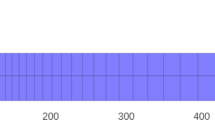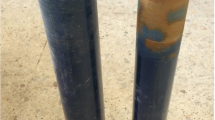Abstract
Deepwater sediments are prone to loss circulation in drilling due to a low overburden gradient. How to predict the magnitude of leak-off pressure more accurately is an important issue in the protection of drilling safety and the reduction of drilling cost in deep water. Starting from the mechanical properties of a shallow formation and based on the basic theory of rock-soil mechanics, the stress distribution around a borehole was analyzed. It was found that the rock or soil on a borehole is in the plastic yield state before the effective tensile stress is generated, and the effective tangential and vertical stresses increase as the drilling fluid density increases; thus, tensile failure will not occur on the borehole wall. Based on the results of stress calculation, two mechanisms and leak-off pressure prediction models for shallow sediments in deepwater drilling were put forward, and the calculated values of these models were compared with the measured value of shallow leak-off pressure in actual drilling. The results show that the MHPS (minimum horizontal principle stress) model and the FIF (fracturing in formation) model can predict the lower and upper limits of leak-off pressure. The PLC (permeable lost circulation) model can comprehensively analyze the factors influencing permeable leakage and provide a theoretical basis for leak-off prevention and plugging in deepwater drilling.
Similar content being viewed by others
References
Aadnøy, B. S., 1998. Geomechanical analysis for deep-water drilling. The IADC/SPE Drilling Conference, Texas, USA, SPE39339 MS.
Aadnøy, B. S., and Belayneh, M., 2004. Elasto-plastic fracturing model for wellbore stability using non-penetrating fluids. Journal of Petroleum Science & Engineering, 45 (3–4): 179–192.
Al-Awad, M. N. J., 2002. Simple correlation to evaluate Mohr-Coulomb failure criterion using uniaxial compressive strength. Journal of King Saud University–Engineering Sciences, 14 (1): 137–145.
Andersen, K. H., Rawlings, C. G., Lunne, T. A., and By, T. H., 2011. Estimation of hydraulic fracture pressure in clay. Canadian Geotechnical Journal, 31 (6): 817–828.
Bender, C. V., Bourgoyne, A. T., and Suhayda, J. N., 1996. Estimating break-down pressure of upper marine sediments using soil boring Data. Journal of Petroleum Science and Engineering, 14 (3): 101–114.
Chang, C., Zoback, M. D., and Khaksar, A., 2006. Empirical relations between rock strength and physical properties in sedimentary rocks. Journal of Petroleum Science & Engineering, 51 (3): 223–237.
Feng, Y., Jones, J. F., and Gray, K. E., 2016. A review on fracture initiation and propagation pressures for lost circulation and wellbore strengthening. SPE Drilling & Completion, 31 (2): 1–11.
Fjær, E., Holt, R. M., Horsrud, P., Raaen, A. M., and Risnes, R., 2008. Petroleum Related Rock Mechanics. Elsevier, Amsterdam, Netherlands, 63pp.
Kaarstad, E., and Aadnøy, B. S., 2008. Improved prediction of shallow sediment fracturing for offshore applications. SPE Drilling and Completion, 23 (2): 88–92.
Li, B., Wang, S., Wang, B., and Tian, B., 2015. Lost circulation status in deepwater of South China Sea and preventive measures. Oil Drilling and Production Technology, 37 (1): 111–114 (in Chinese with English abstract).
Li, Z., Fang, M., and Li, L., 2015. Drilling practices of deepwater well in west of South China Sea. Oil Drilling and Production Technology, 37 (1): 92–95 (in Chinese with English abstract).
Lin, B., Jin, Y., Pang, H., and Cerato, A. B., 2016. Experimental investigation on dilation mechanisms of land-facies karamay oil sand reservoirs under water injection. Rock Mechanics and Rock Engineering, 49 (4): 1425–1439.
Risnes, R., Bratli, R. K., and Horsrud, P., 1982. Sand stresses around a wellbore. Society of Petroleum Engineers Journal, 22 (6): 883–898.
Santos, H., 2002. Increasing leakoff pressure with new class of drilling fluid. The SPE/ISRM Rock Mechanics Conference, Texas, USA, SPE/ISRM78243.
Sharan, S. K., 2003. Elastic-brittle-plastic analysis of circular openings in Hoek-Brown media. International Journal of Rock Mechanics and Mining Sciences, 40 (6): 817–824.
Sun, J., 2016. Prediction of reasonable injection pressure for stimulation of water-injection wells in poorly consolidated sandstone reservoir. PhD thesis. China University of Petroleum, Beijing.
Sun, J., Tang, J., Zhang, B., Yin, D., Yu, B., Zou, S., and Liang, H., 2005. Methods for testing properties of ultra-low permeable drilling fluid. Petroleum Drilling Techniques, 33 (6): 25–27 (in Chinese with English abstract).
Sun, Q., Yan, C., Deng, J., Yu, B., Liu, S., Liu Z., and Xiao, K., 2015. Calculation method for fracture pressure of deep sea shallow formation. Journal of Central South University (Science and Technology), 46 (4): 1402–1408 (in Chinese with English abstract).
Tang, T., and Mcdonough, J. M., 2016. A theoretical model for the porosity-permeability relationship. International Journal of Heat and Mass Transfer, 103: 984–996.
Wang, Y., and Wu, B., 2001. Borehole collapse and sand production evaluation: Experimental testing, analytical solutions and field implications. Bmc Infectious Diseases, 12 (14): 584–584.
Yan, C., Deng, J., Hu, L., and Yu, B., 2013. Fracturing pressure of shallow sediment in deep water drilling. Mathematical Problems in Engineering, 2013: 377–384.
Zamora, M., Broussard, P. N., and Stephens, M. P., 2000. The top 10 mud-related concerns in deepwater drilling operations. The SPE International Petroleum Conference and Exhibition, Villahermosa, Mexico, SPE59019.
Zhang, J. G., Lei, G. L., and Zhang, Y. Y., 2006. Hydrocarbon Reservoir Seepage Mechanics. China University of Petroleum Press, Dongying, 37pp (in Chinese).
Zhang, S., Shen, C., and Deng, J., 2000. Testing study on the law of permeability variation in process of rock deformation and damage. Chinese Journal of Rock Mechanics and Engineering, 19 (S1): 885–888 (in Chinese with English abstract).
Acknowledgements
This work is supported by the National Basic Research Program (973 Program, No. 2015CB251201), the National Science Foundation Innovative Research Groups (No. 51221003) and the Science Foundation of China University of Petroleum, Beijing (No. ZX20150192).
Author information
Authors and Affiliations
Corresponding author
Rights and permissions
About this article
Cite this article
Tan, Q., Deng, J., Sun, J. et al. Leak-off mechanism and pressure prediction for shallow sediments in deepwater drilling. J. Ocean Univ. China 17, 65–71 (2018). https://doi.org/10.1007/s11802-018-3493-y
Received:
Revised:
Accepted:
Published:
Issue Date:
DOI: https://doi.org/10.1007/s11802-018-3493-y




